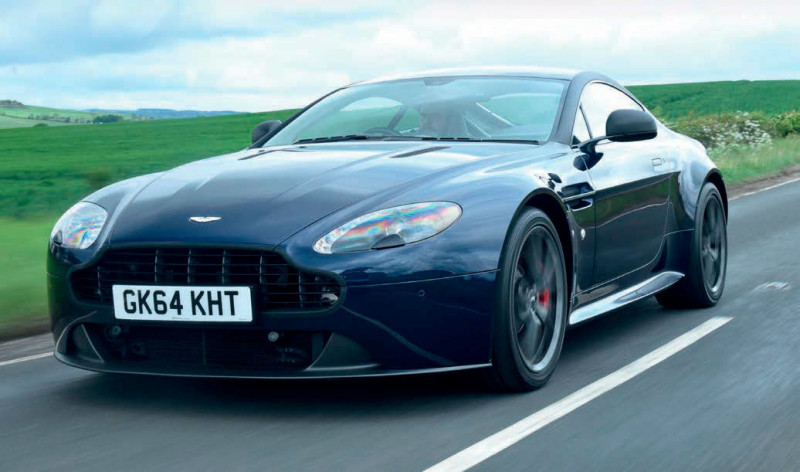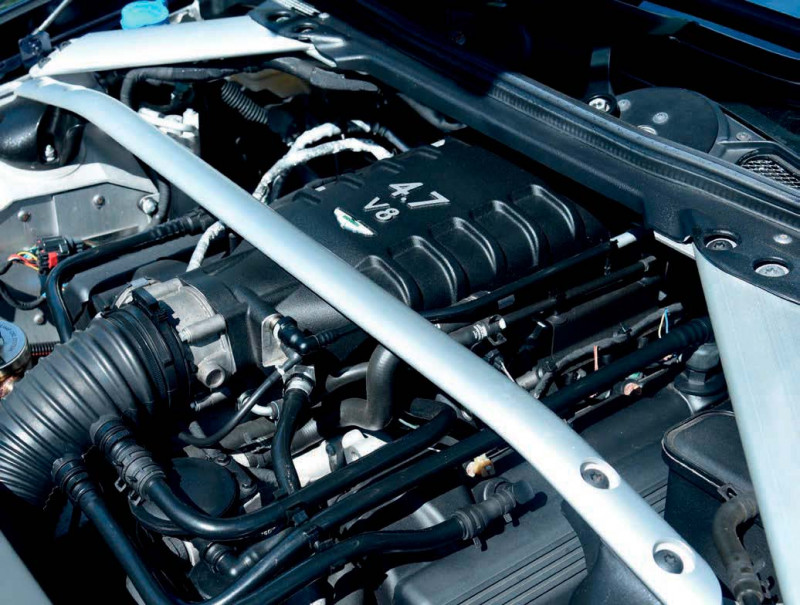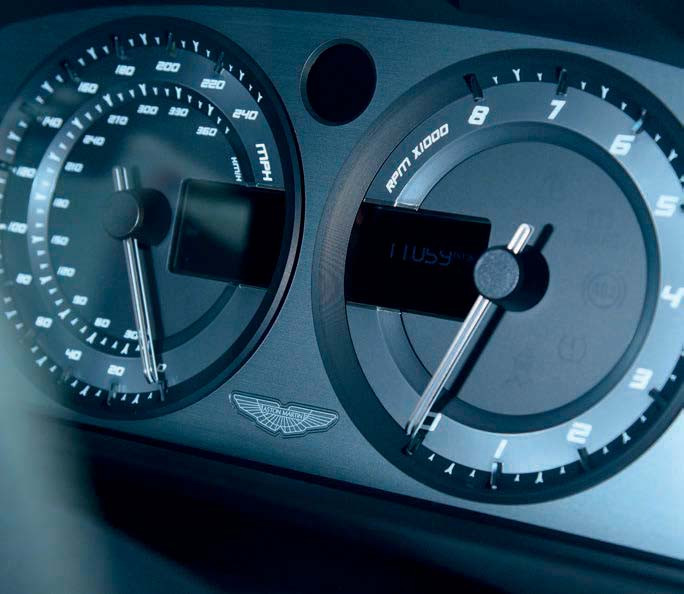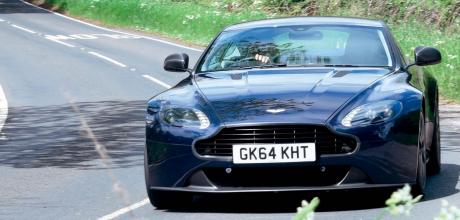2014 Aston Martin Vantage N430 Coupe
Should one of a hundred Nürburgring-themed 2014 Vantage N430 Coupe models be mothballed as a potential investment or simply be driven and enjoyed for the purpose it was designed for? We hit the roads of County Durham to find out.
A QUESTION OF COLLECTABILITY 2014 VANTAGE COUPE
WORDS: ROB HAWKINS
PHOTOGRAPHY: PAUL WALTON
VANTAGE N430 BETTER BUY THAN A VANTAGE S?
Is this limited edition really collectable? Or is it better touse it and enjoy it the way it was meant to be driven?

Everything seems to scream extra special when you look over the eight-year-old Vantage N430. There are under 12,000 miles on the odometer of this example and a clean bill of health for all of its MOT tests, so no matter how rare and collectable this Aston Martin may be, it’s a good starting point to know it has been looked after and hardly used. Obvious differences from the standard model include the N430 badges on the rear and the sill covers, along with the embroidering in the headrests for the front seats.

This Mariana Blue car should also have garish red stripes along the cant rails, up the windscreen pillars, around the front grille, along the front splitter and over the door mirror covers. A previous owner has toned them down with a removable wrap of carbon fibre-effect vinyl. Maybe I’m getting old, but I’ve seen too many Citroen Saxos and Honda Civics with colour mismatching akin to a standard N430 in an attempt to look different and to buck the trend – and the carbon fibre is a far more muted and discreet alternative in my opinion. Such outrageous colour-coding can work if it’s done subtly, such as on the Vantage F1 Edition we featured in the first issue of AMD with its bonnet stripe – but not when the clash is so extreme. The idea behind it all was to give a nod to the DBR1 with its green and yellow paintwork, but some of the options offered on the N430 were not quite so elegant.

The interior is suitably upmarket, though, and nothing near as controversial as the exterior should be. For instance, the Alcantara over the top of the instrument binnacle, along with the carbon fibre surround for the gear lever and the digital displays to accompany the traditional analogue speedo and tacho are all subtle limited-edition features. Originally, the framework for the front seats would have been constructed from Kevlar and carbon fibre to create a high-back bucket-style upholstered in leather, but this model has a pair of standard seats (except for the embroidered logos) so they remain fully electronically adjustable via the switches on the gearbox tunnel.
This car has a few costly optional extras, such as Bluetooth connectivity that would have cost £495 when ordering, along with cruise control for an extra £295. Modestly priced extras when you find out how much the sat-nav with its pop-up screen would have cost. A whopping £1795 extra. It looks impressive when it rises out of the top of the dashboard, but such a price would be hard to justify now, especially considering most mobile phones off er a better service. While these options were standard on the Vantage S – a car which is now more affordable than the N430 despite costing £7000 more when new – a direct comparison on price and value is not straightforward.
Under the skin of the N430, most of the mechanical components are taken from the Vantage S – making it an easier comparison on paper. The suspension, for instance, which comprises upper and lower wishbones and coilovers at each corner with front and rear anti-roll bars, includes the S-spec electronically controlled dampers. The dinner platesized brake discs all round with multipiston calipers include ABS and traction control as you’d expect from a 2014 model, but also brake assist (more on that later).
Under the bonnet, there’s a naturally aspirated 4735cc all-aluminium quad-cam V8 (four valves per cylinder) with a 11.3:1 compression ratio and a dry sump system. On paper, there’s 430bhp at 7300rpm and 490Nm (361 lb ft) of torque at 5000rpm — the same specification for the Vantage S. But the N430 had lightweight forged alloy wheels — and those Kevlar and carbon fibre seats to help reduce the overall weight by 20kg (hardly worth the bother when the total unladen weight is 1,610kg, making it a mere 1.2% reduction). Choosing a six-speed manual gearbox also helped to save £5,000 over the seven-speed automatic option with a paddleshift. Then there’s the paintwork – while divisive, it does mark the N430 out as a rarity.
When launched, the N430 had some stiff competition from the likes of Audi’s R8, Porsche’s 911 3.8 Carrera S and Jaguar’s F-TYPE R, all of which were priced around the £90k mark alongside the £89,995 Aston. Even the BMW M6 coupe was a contender of sorts for similar money. The only winner on price was the Chevrolet Corvette Stingray at £61,495, although it’s not really a consideration for most Aston Martin customers. Nowadays, the Porsche has depreciated the least in value.
The argument for the N430 being a potential investment and worthy of being mothballed perhaps concerns its limited-edition predecessors, the N400 and N420. With Vantage V8 production ending in 2017, the N430 was the last of the line for the Nürburgring-themed models, so it could possibly be the best, or at least the most desirable. Will this translate into investment potential? Only time will tell. On the other hand, how about simply buying one of these cars to use and drive? After all, it’s pretty much a Vantage S by another name, and there’s surely no desire to preserve one of these for future collectability?
Keen to find out, I’ve borrowed this example from Aston Workshop, which lists two N430s on its website. It took a few minutes of looking for a start/stop button and realising there wasn’t one to realise that the key fob doubles up as a starter button once inserted into the dash. Spatial awareness and the proportions of the N430 take a few minutes to adjust to from inside. In theory, it’s a small vehicle in some ways – it’s a mere 43cm longer than a Mk1 Mazda MX-5 at 4.38m (172.6in), but some 10cm wider than a Jaguar F-TYPE. From the inside, there are blind spots everywhere, although the reversing cameras and door mirrors do their best to help — the door mirrors angle themselves downwards when reverse is selected, then flip back up when you move forwards again, a useful feature that has the potential for the mirrors to tie themselves in knots if you are rapidly moving forwards and backwards to parallel park in a tight space.
Fortunately, after a few minutes I knew where each wheel and corner was located. I also discovered the intelligence of the reversing cameras when they almost screamed at me for reversing out of an entrance to a field and on to the road during our photoshoot. Something had picked up the markings on the tarmac and quickly warned me I was going backwards on to a main road.
Other impressive features include the brake assist that I mentioned earlier. It can be annoying if it’s too keen and restricts setting off, but on this N430, it was perfect for eliminating the use of the flyoff handbrake for hill starts. And it’s also clever enough to apply brake assist only when needed – when setting off on hills, for instance. It’s a feature that’s not really necessary on such a car with a separate mechanical handbrake caliper on the rear discs, but it won my vote in this case.
Other aspects that bowl me over include the manual gearbox. I admit I can put up with an automatic gearbox, especially one with a paddleshift, but I always prefer a clutch pedal and a stick for ultimate gear control. With six forward gears, I’d read some press reports from 2014 that slated this manual gearbox, yet I couldn’t find any problems with gear selection on the move, whether I was changing up or down the ‘box. On one occasion I did make the mistake of deselecting reverse and being too quick to select what I thought was first, only to find I was setting off in third gear! Luckily, the torquey V8 didn’t complain and got on with it. Sadly, reverse gear isn’t so easy to select as the six forward gears, so perhaps that was the criticism highlighted in those press reports. It’s alongside first gear, requiring the gearlever to be pushed down a little. It was often quite notchy to select, but never failed to engage.
Initially, I had reservations over this N430’s steering. It’s hydraulically power assisted, which those old press reports praised for being positive and better than the emerging electronic systems of the time that were regarded as vague. At first, the heaviness of the steering felt as though the drivebelt to the power steering pump was possibly missing. It’s also consistently heavy at all speeds and over all surfaces. Whilst three point turn manoeuvres aren’t exactly hard work, I did wonder whether the steering could do with being a little lighter. Yet it all became apparent when I started to be more confident with tackling corners at faster speeds. The steering remained positive at all times, especially under hard cornering, with no feedback. It was only at very slow speeds that I became concerned with the occasional tramline of the tyres and subsequent pulling on the steering.
I soon realised that I needed to and could confidently be as aggressive as I wanted to be with this N430, although I suspect I wasn’t trying hard enough when Aston Workshop managing director, Dave Cummings, joked that if I could look at the speedo when driving, I wasn’t driving fast enough. It’s easy to drive this Aston sedately, despite what its performance figures say. Consequently, you have to make a determined eff ort to drive it at the limit, when the noise from the induction and exhaust changes to a guttural growl and all hell breaks loose. For country lane test-driving, such opportunities are limited, but there are more chances to brake and corner hard and exit just as hard, which this N430 does with the minimum of fuss. The brakes are pinsharp for road use. The suspension is firm, but keeps most of the feedback away from the driver. I could occasionally hear minor panel rattles, but would have been more concerned with hollow knocking and the feeling of scuttleshake, of which there was none. The entire car noticeably pitched over particularly rough country lanes, which was at first a little alarming, but once I tuned into its handling characteristics, I could accommodate this typical shortfall of a smallish car with an equally short wheelbase.
I soon realised this N430 is an ideal candidate for a country lane blast to blow the cobwebs away. It’s quiet and refined enough for a long trip, although limited in luggage space, so that would be a little challenging. Instead, it’s a toy for the weekend and wouldn’t embarrass itself on a track day.
Returning to the original point of this article, could this N430 also be a viable investment? It ticks the boxes for rarity and limited-edition features, although there are quite a few such models, so perhaps it’s more reassuring to note that it will probably hold its value better than a standard Vantage or even an S. Cars are surely meant to be driven, and no more so than this N430.
Thanks to: Aston Workshop; 01207 268932; aston.co.uk. The pictured car is for sale at £64,950


